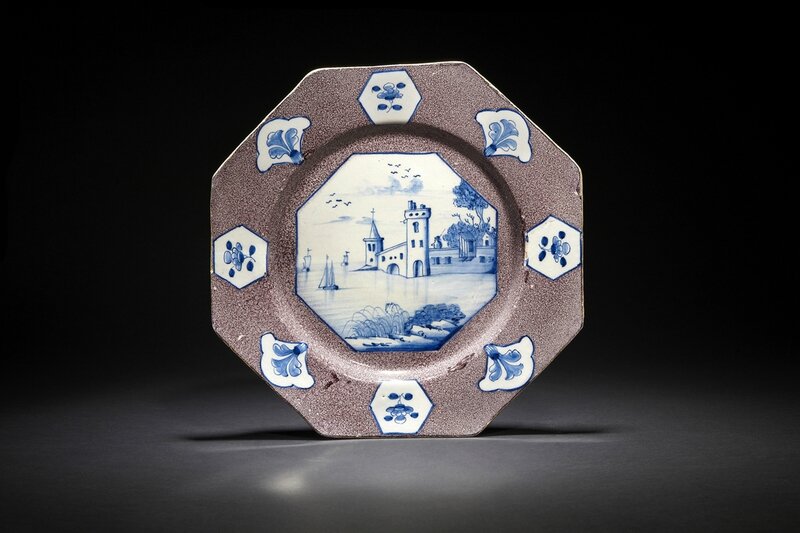An English Delftware Powdered-Manganese Octagonal Large Dish, Circa 1740, Bristol Or Wincanton
An English Delftware Powdered-Manganese Octagonal Large Dish, Circa 1740, Bristol Or Wincanton © 2014 Rodney Woolley.
12 in. (30.5 cm.) wide. Price: GBP 2,500 (USD 4,000)
Painted in blue with an estuary scene of sail boats beside fortified buildings within an octagonal cartouche below a circular well, the border reserved with four hexagonal panels of flowers divided by trefoil panels of leaves
Cracked form rim, consolidated and over-painted to the upper surface, the repaired crack is visible to the reverse, some chipping, in-filling and restoration to the rim at several corners.
Manganese-purple was the most commonly used ground colours, although, more unusually blue and more unusual still, powdered green, yellow (sometimes mingled with iron-red) and a `dead-leaf’-brown ground were used on wares and to frame wall-tiles. Tiles decorated with a ground of powdered iron-red also known (see Jonathan Horne, ` English Tin-Glazed Tiles’ [1989], pp. 23 and 62, nos. 47 and 337, see the Lipski Collection of English and Irish Delftware, sale Sotheby’s, 10 March 1981, lot 174 (part), also Ray III, p. 213, nos. 486 and 488). The powdered metal oxide is applied onto the white tin-glazed ground with cartouches were reserved using paper stencils (Garner and Archer [1972], p. 35). The pigment could be applied dry or wet, producing different effects, generally it appears that the ground colour was applied and the reserves were then decorated. Though in 17th century inscribed wares the blue inscriptions are applied first and then covered before the manganese speckled ground is applied (see the inscribed caudle cup in the collection of Colonial Williamsburg, illustrated John C. Austin, `British Delft at Williamsburg’, (1994), p. 104, no. 88, where the powdered manganese is clearly applied on top of the blue border of the inscribed rectangular panel).
The second quarter of the 18th Century saw a revival of the powdered-ground technique, perhaps inspired by the English translation of Abbé d’Entrecolles’ account. The earliest dated powdered ground wares include a documentary plate form Wincanton in the Glaisher Collection. Manganese-purple and cobalt-blue are the most commonly seen although a broader range of colours were employed. The technique was used to decorated plates and dishes, punch bowls and smaller pieces of form such as flower bricks as well as tiles. The designs showed more complexity than the 17th century wares. The flat surface of a plate or dish would be reserved with a central cartouche radiating further smaller panels. The panels were decorated with blue, polychrome or iron-red vignettes of Asian or European inspiration, inscriptions or verses. `Grace’ plates, electioneering plates and estuary scenes of the Battle of Portobello appear to be relatively commonly combined with a powdered manganese-purple ground. The reserves to the border were of increasing sophistication, the borders could use geometric designs.
Surviving dated pieces suggest the technique was popular on delftware from about 1738-1754 and was also used by contemporary creamware pioneer Enoch Booth on wares dated 1743. Speckling was later employed to great effect by Josiah Wedgwood on engine-turned ornamental forms of Classical inspiration which were decorated in combinations of manganese-purple, cobalt-blue and dark copper-green made in imitation of porphyry. This style of ground decoration is seen used simultaneously on the Continent, particularly in Northern Europe in centres such as Rotterdam, Brussels, Erfurt and Berlin amongst others and parallels can be drawn with wares made at Pavia in Northern Italy.
Contact: rw@rodneywoolley.com - http://rodneywoolley.com/

/https%3A%2F%2Fprofilepics.canalblog.com%2Fprofilepics%2F1%2F0%2F100183.jpg)
/https%3A%2F%2Fstorage.canalblog.com%2F03%2F02%2F119589%2F96711876_o.jpg)
/https%3A%2F%2Fstorage.canalblog.com%2F11%2F31%2F119589%2F94773502_o.jpg)
/https%3A%2F%2Fstorage.canalblog.com%2F20%2F83%2F119589%2F94772815_o.jpg)
/https%3A%2F%2Fstorage.canalblog.com%2F26%2F72%2F119589%2F75604929_o.jpg)
/https%3A%2F%2Fstorage.canalblog.com%2F59%2F60%2F119589%2F26458628_o.jpg)




/http%3A%2F%2Fstorage.canalblog.com%2F40%2F89%2F119589%2F128370741_o.jpg)
/http%3A%2F%2Fstorage.canalblog.com%2F08%2F49%2F119589%2F92797375_o.jpg)
/http%3A%2F%2Fstorage.canalblog.com%2F51%2F84%2F119589%2F122518624_o.jpg)
/http%3A%2F%2Fstorage.canalblog.com%2F76%2F68%2F119589%2F122516055_o.jpg)